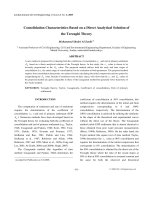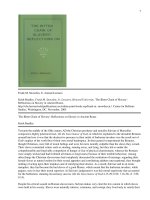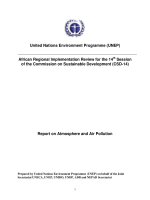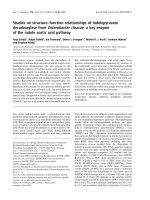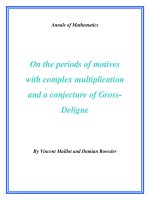Reflections on the announcement june 14th, 1965 of the Vietnam bishops hierachy on a half century occasion
Bạn đang xem bản rút gọn của tài liệu. Xem và tải ngay bản đầy đủ của tài liệu tại đây (696.26 KB, 8 trang )
Religious Studies. N0.01 & 02 - 2015
43
PHẠM HUY THÔNG *
REFLECTIONS ON THE ANNOUNCEMENT JUNE 14th, 1965
OF THE VIETNAM BISHOPS HIERACHY ON A HALF
CENTURY OCCASION
Abstract: The Chinese rites controversy lasted for 294 years (1645
- 1939) and it caused many damages to the Roman Catholic
Church in Asia included Vietnam. In order to solve this issue, the
Holy See announced “The Exhortation Plane compertum est”.
After the Second Vatican Council, Vietnam Bishops demanded to
execute this Exhortation and the Announcement the 14th of June,
1965 approved Vietnamese Catholics venerate their ancestors and
national heroes. In the spirit of cultural integration, the
Catholicism has transformed from a strange religion into a close
religion to the Nation. However, it has appeared some issues that
need to solve.
Keywords: Catholicism, Vietnam Bishops Council, Chinese rites,
cultural integration, venerate ancestor, vietnamesation of
religion.
It has been a half century since The Catholic Bishops’ Conference of
Vietnam released the Announcement June 14th, 1965 on reverence of
ancestor and heroic martyrs. This announcement was followed by the
proposal of The Catholic Bishops’ Conference of Vietnam on applying
the Instruction Plane compertumest December 8th, 1964. The
Announcement not only ended the consequences of Chinese Rites
Controversy lasted 294 years from the Pope Innocenté X issued the
decree on banning worship rites of ancestor and Confucius to the
Instruction Plane compertumest was released in 1939, but also removed
obstacles for Vietnamese following Catholicism and for Catholicism in
Vietnam not being strange with the community. On the occasion of a haft
century of releasing the Announcement, we would like give some
thoughts about practicing this announcement.
*
PhD., Centre for Thinking Science (CTS), Hanoi, Vietnam.
44
Religious Studies. N0.01 & 02 - 2015
Firstly, we think that the Holy See changed its viewpoint on Chinese
Rites not due to dozens of thousands of Catholic martyrs, but the rigid
and conservative of Vatican on this problem. When the Đàng Trong and
Đàng Ngoài Dioceses were established, the Holy See sent first two
bishops to Vietnam including Francois Pallu and Lambert de la Motte,
and approved the text Monitaad Misinarios (Instructions to the
Missionaries). This text expressed many aspects of inculturation, but 300
years later, it was mentioned by the Second Vatican Council. The Holy
See instructed these bishops as following: “Brothers must not try to
change, or force people to change their etiquette, customs unless they
contradicted the Deity teachings and moral. What would be more
unreasonable than imposition France, Spain, Italy or any other countries
in Europe on East Asian people? It was false that carrying these things
for them as the truth of faith to exclude rites and customs of any ethnics,
as well as violate these rites and customs even they were not bad. In
contrast, the truth must help people to reserve and maintain these”1.
Thus the Holy See at that time was not conservative and cultural
imposition on the nations. However, this viewpoint of inculturation was
not popular and practiced in the world and Vietnam at that period due to
series of subjective and objective reasons as well as practical situation.
Of course not after the Instruction Plane compertumest 1939,
Catholicism’s inculturation began in Vietnam. According to the
writings of early missionaries, as soon as Catholicism appeared in
Thăng Long - Kẻ Chợ in 17th century, Catholics used coconut leaf
instead of olive leaf in the Rite of Palm, used Lunar New Year pole
with the Holy Cross at its top, used the alexandrine to express the Bible
and some Vietnamese cooperated with missionaries to latinize the SinoNom for creating Quốc Ngữ language of Vietnam nation. Some
missionaries in Vietnam respected local custom very much. Priest
Martini recounted the story of priest Onofre Borges attending the death
anniversary of Lord Trịnh Tráng held by Lord Trịnh Tạc as follow:
“The father respected local custom, complied with Vietnamese rite,
went barefoot, worn brown robe, kowtowed as Vietnamese style, that
made Lord Trịnh satisfied, then he commanded to turn on the music
which was just for Lord. So everybody surprised and thought that the
Lord bestowed the father a noble title”2.
̣ m Huy Thông. Relections on the Announcement...
Pha
45
Priest Alexandre de Rhodes (Đắc Lộ) also discussed on the rite of
ancestor worship and confirmed that: “I recounted this quite long rite in
the Historie du royaume de Tunquin (History of the Kingdom of Tonkin).
In fact, there were some rites, if the Catholics performed them, they
would not be sinned, and even they were innocent. We asserted that they
could maintain these rites which were not harm to Catholicism” 3.
Even Bishop Pigneau de Behaine also disapproved with the
prohibition of the ancestor worship and protected this rite of local
residents. The Bishop wrote that: “All things were said about invocation
of dead, cult of idols that were assigned to ludicrous, unacceptable with
people living in this region. The missionaries and whoever living in the
region never blamed these customs in which they came to preach. Please
report to the Catholic Church that, until I died, I still maintained my
viewpoint on bowing before dead parent’s coffin of the East Asians”4.
Secondly, there were many points that explained the Nguyen Dynasty
banning Catholicism due to this religion not allowed its believers to
worship of their ancestor, for example: “The Vietnamese kings prohibited
the Catholicism not due to fanaticism but they wanted to reserve the unity
of nation on spirit and politics. The Catholics did not worship of ancestor
that could damage this unity of spirit. In addition, some missionaries
incited the new Catholic believers against the feudal government to
establish a government which could support the Catholicism” 5, or “The
Catholicism did not allow believers to worship of ancestor that was
disloyal, unfilial”6.
It was not accurate if someone said that the Catholics did not revere for
ancestor. Catholicism ruled in the Fourth of Ten Commandments as “To be
filial to parents”. This filial piety to parents is not only expressed while
they are alive but also they died. In the Catholic Liturgical Calendar, the
November is the month to pray for the dead people, and in the three days
of Tet holiday there is one day to pray for ancestor. In the first lecture for
catechumens, the missionaries also taught that: “There are three superiors
as three fathers who we have to worship. The parents born our body…
There were parents therefore our body was born. We indebted our mum
who was pregnant in the nine months and ten days, suffered difficulties to
bear our, then done breastfeeding for three years. The mother passed food
from her mouth to her child; even she ate bitter food to reserve delicious
45
46
Religious Studies. N0.01 & 02 - 2015
food for her child. She did lying in the wet place but the clean place for her
child. The father raised us so that the father sat up late and got up early to
work, managed to make money to raised children. Therefore we have filial
piety to our parents that is right, if not is moral sin”7.
The Catholics still are filial to their parents, but they expressed the
filial piety following the way, especially after their parents passed away,
which was different from the ancestor worship and other religions,
however it was not a basic reason that caused to the policy banned
Catholicism. Appearance of the religion being different from the Kings’
religion was a main reason caused to the conflict. While researched the
Oriental religions, the Chilean Professor of history S.V. Rojo concluded
that: “Due to there was always a reign of the King’s religion as a national
religion. The standard regulation here was the religion of King. So that
converting to other religion would lead to changing the content of
political thought immediately”8.
Thirdly, while integrated with Vietnamese culture, the Catholicism
changed from a strange religion to a quite familiar religion with
Vietnamese people. From liturgy to rites, religious life style of the
Catholics; from literature, art, press to customs in the Catholic villages,
all of them were marked by Vietnamese culture beside Catholic
characteristics.
On the architecture, the Catholic churches, typically as Phat Diem
Stone Church, Kontum Wooden Church, even some new churches as Cua
Nam Church (Lang Son province), Cam Ly Church (Da Lat city),
Pleichuet (Gia Lai province), etc., mixed with some features as a roof of
communal house, a roof of pagoda which were familiar to Vietnamese
and some architectural features of minor ethnics.
On the music, when the Lê Bảo Tịnh music band was established in
July of 1945 with slogan “on the content of music which was service of
the God and the Nation, on the art of music which was based traditional
music for rhythm structure”, the sacred music in Vietnam appeared many
special songs such as Đêm Đông (Winter Night) by Hải Linh, Kinh Hòa
Bình (Peace Prayer-book) by Kim Long. Today, in the Catholic sacred
music in Vietnam there are many rhythms of folksongs such as Bắc Ninh
folksong, Lạng Sơn Then singing, Huế chanty, Southern folksong as well
as fiery rhythms of Jarai in the Central Highland.
̣ m Huy Thông. Relections on the Announcement...
Pha
47
On the art, through Catholicism, the Vietnamese people knew some
famous art works in the world as The Last Supper of L. de Vinci, The
Virgin Mother of Rafael. Nowadays, they also can see images of
traditional Vietnamese people through the oil painting, statue Đức Mẹ
Việt Nam (Our Lady of Vietnam) by Nam Phong, the lacquer painting
Christmas by Nguyễn Gia Trí, the statue Đức Mẹ La Vang (Our Lady of
La Vang) by Văn Nhân, and oil paintings of Lê Văn Đệ, Nguyễn Thị
Tâm, etc. When someone looked at the painting Madalena under the
Cross, it realized that this goddess was a Vietnamese women with long
hair over her shoulders and big opened eyes, confided under the Cross. If
you looked at the picture Our Lady of Vietnam, you still realized that was
a picture of Vietnamese Mother carrying sleeping baby.
Today, the Catholic ceremony takes place with many features that are
similar to the festival village such as the drum team, the man with long
coat with turban, the women with long garment, the palanquin mounted
dragon’s head, the parasol with symbol of phoenix as well as the dancing
clown with a big drum. But in the Catholic ceremony there is an extra
team as brass trumpet team.
The Catholics tried to do Vietnamization of their religion very early
with beginning from foreign nouns as Vincente called Vinh Sơn,
Benedict called Biển Đức. The foreign missionaries also applied the
lifestyle “When in the Rome, do as the Romans do” for using their names
in order to be familiar to the Vietnamese, for example, Alexandre de
Rhodes called as Đắc Lộ, Pigneau de Behaine called as Bá Đa Lộc. In
addition, they also spelled Deus as Chúa Dêu or Chúa Trời, etc.
On the literature and art particularly, Catholicism succeeded in
creating many themes for the writers and artist in Catholicism as well as
outside this religion. There were some authors who succeeded both in
proposing attractive themes and the art. For example, it was the poem of
Hàn Mặc Tử (1912 - 1940). Literary critics Hoài Thanh and Hoài Chân
extremely praised that “Hàn Mặc Tử built his own church for praying the
God. If I did not believe in the God, I was only a strange visitor and
could not kneel down and pray together with the poet. But could my soul
not be disregard, could my mind not non-overwhelm before the glorious,
solemn, sparkling, fanciful palace? There were strange beautiful verses
that were spelled as blowing a light into the soul, etc. The poem of Hàn
47
Religious Studies. N0.01 & 02 - 2015
48
Mặc Tử was created and it demonstrated that Catholicism in this region
created a space crystallized into poems”9.
The immortal poems and writings such as Kinh cầu Đức Bà (Lady
prayer-book), Dâng hoa (Flower offering), Hang đá (Cave), millions of
Sino-Nom words of Maijorica, wirttings by Philippe Bỉnh, then later the
works as Sấm truyền ca, Tạo đoan kinh, Lập quốc kinh by Priest Lữ Y
Đoan (1613 - 1678) and Hiếu tự ca by Priest Trần Lục, etc.
The Catholics also created their own store of proverbs and folksongs
in any regions of Vietnam. In the experience on climate, there were some
statements: “The Epiphany means crabs and fishes will die” (January 6th)
or “The Presentation of Jesus at the Temple means the Tet holiday is
coming very closely”. In the experience on production, there were some
statements: “The ceremony of Our Lady of the Rosary means at time for
sowing pumpkin seeds” (October 7th), “The All Saints’ Day means
harvesting pumpkin” and “The All Saints’ Day means sowing rice seed”
(November 1st), “The Christmas Day means uprooting rice seedlings to
plant” (December 25th).
In addition, the Catholics in each local region had got particular
summaries. In Bùi Chu diocese, there was a statement: “The fathers in Phú
Nhai, the yam in the Chùa market”. The yam in the Chùa market (Nam
Trực district, Nam Định province) was famous delicious and so much
whereas Phú Nhai was famous because it was the hometown of over 100
priests and 5 bishops. In Phát Diệm diocese, there was a statement: “The
Scripture of Thể, the rite of Sâm, the tray of Sáu, the grandchildren of
Thịnh”. It was explained that Priest Thể tested the Scripture of marriage
very strictly; Priest Sâm held a ceremony in the church that was very long
and bored, Priest Trần Lục had got a big bronze tray and Thịnh had got
many grandchildren. In Hanoi, there was a statement: “The Mandarins in
Vụ village, the Priests in Báng village” which meant Vụ Bản village was
hometown of mandarins and Kẻ Báng was hometown of priests.
Fourthly, after a half of century practiced the Announcement June
14 , 1965 of the Vietnamese Bishop hierarchy, the Catholic Church has
achieved many results and gradually built the Vietnamese Catholic
Church but not the Catholic Church in Vietnam. However, the process
also faced many challenges which required historians, writers,
theologians, sociologists, etc to solve jointly.
th
̣ m Huy Thông. Relections on the Announcement...
Pha
49
In the inculturation trend, the Catholicism did the Vietnamization to
become friendly as well as to highlight Vietnamese. But it would raise a
question: How was the history? For example, in the Christmas we
described Giuse as a farmer with brown clothes, Mother Maria as a
Vietnamese woman with áo dài (long dress) and kerchief, beside some
buffaloes and bamboo trees. Describing such that would raise a question:
Where was Jesus born? In Vietnam or Belem? This problem was same to
the music aspect. It is wondered that whether it was appropriate to use
Bible words in the traditional music or not.
This problem was raised to the clothes of Jesus or Maria. In the
Catholic viewpoint, Jesus and Maria are very humble. But it was seen
that Jesus wears as a king and Maria wearing as a queen with lots of
treasures in many Catholic pictures, statues in Vietnam. By this way,
would it honored or alienated the Catholics? When some researchers
visited the La Vang and Trà Kiệu, they said that Mother Trà Kiệu was
familiar to believers and more humble. Of course, Mother Maria was the
Mother of God, so that how much gold, silks and satins would not equal
her. However, I was not sure whether we should do that to bring the
Mother Maria and God to believers more closely.
In the relationship with other religions, Catholicism advocated the
slogan “Living the Catholic faith follows the Vietnamese style”. In the
past, there were “Xôi đỗ” villages with Catholics mixing others which
were the characteristics of Catholicism in Vietnam. Today, there are not
only Catholicism and Buddhism but also many other religions coexisting
in a community. From considering other religions as heresy and popular
religion to consider them as friends was the great progress of Catholicism
in Vietnam. However, this friendship among religions is remaining at
visits on the rite day and Tet holiday or allowing their believers together
build the churches, pagodas. They have not yet cooperated to resolve
social issues. To do such those, it is necessary to establish some
Associations of religions with larger operational programs.
Commemorating heroic martyrs raised lots of questions. For example,
beside Quang Trung, Trần Hưng Đạo, Nguyễn Trãi, etc., who were
meritorious heroes, there were many controversial heroes in the Vietnam
history. A question was set up that whether they were meritorious or
criticized so that Catholics rarely organized ceremony of heroic martyrs
49
50
Religious Studies. N0.01 & 02 - 2015
because they were afraid of committing with politics. If they were
invited, they would participate but rarely participated actively. In the
contrast, Catholicism teaches that believers have to pray for living and
died people. It was a reason making Catholics hardly to choose.
The Catholic Church was based the faith. All of things in Catholic
inculturation has to be based this faith. However, we still prefer the
statement of Pope Francis: “I prefer a church which is bruised, hurting
and dirty because it has been out on the streets, rather than a church
which is unhealthy from being confined and from clinging to its own
security”10./.
NOTES:
1 Religious Life of Catholics following Vietnamese Style, The Proceedings of
Scientific Round Table, Hanoi Religious Publishing House, 2004: 164.
2 Marini (1666), Histoire Nouvelle et Curieuse des Royaumes de Tunquin et Laos,
Paris: 324.
3 A. de Rhodes (1653), Histoire du Royaume de Tunquin, Paris: 76 - 77.
4 Phạm Huy Thông (2012), The Interaction of the Catholicism and the Vietnamese
Culture, Religious Publishing House, Hanoi: 141 - 142.
5 Le Thanh Khoi (1955), Le Vietnam, Histoire et Civilisation, Paris: 310.
6 Nguyễn Đăng Duy (1996), The Spiritual Culture, Hanoi Publishing House: 275.
7 A. de Rhodes (1993), Catechism in Eight Days, Đắc Lộ publishing: 17-19.
8 Institue for Religious Studies (1994), On the Religion, Vol. 1, the Social
Sciences Publishing House: 223.
9 Hoài Thanh, Hoài Chân (1988), The Vietnamese Poets, The Literary Publishing
House: 206.
10 The Teaching Lecture of the Fourth Day, 26th, April, 2014,
htt://vietcatholic.news
REFERENCES:
1. Nguyễn Đăng Duy (1966), The Spiritual Culture, Hanoi Publishing House.
2. Le Thanh Khoi (1955), Le Vietnam, Histoire et Civilisation, Paris.
3. Marini (1666), Histoire Nouvelle et Curieuse des Royaumes de Tunquin et Laos,
Paris.
4. A. de Rhodes (1653), Histoire du Royaume de Tunquin, Paris.
5. A. de Rhodes (1993), Catechism in Eight Days, Đắc Lộ publishing.
6. Religious Life of Catholics following Vietnamese Style, The Proceedings of
Scientific Round Table, Hanoi Religious Publishing House, 2004.
7. Hoài Thanh, Hoài Chân (1988), The Vietnamese Poets, The Literary Publishing
House.
8. Phạm Huy Thông (2012), The Interaction of the Catholicism and the Vietnamese
Culture, Religious Publishing House, Hanoi.
9. Institue for Religious Studies (1994), On the Religion, Vol. 1, the Social
Sciences Publishing House, Hanoi.

